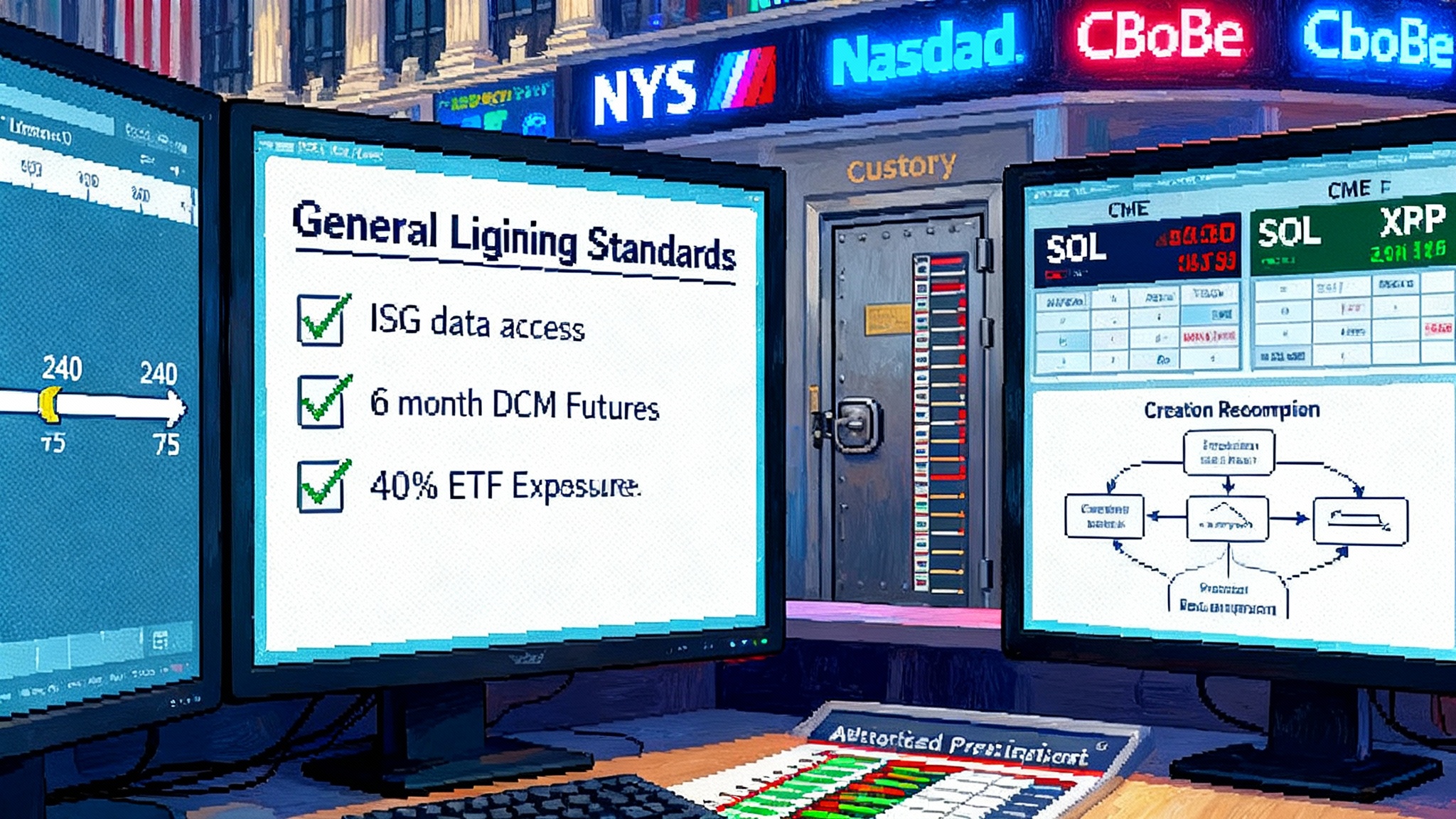America’s spot crypto pivot: first movers, fees, and timing
A rare SEC-CFTC joint signal just opened the door for registered US exchanges to list certain spot crypto products. Here is what surveillance, custody, cross margin, fees, and a 3 to 12 month rollout could look like, plus who moves first.

The pivot that could onshore crypto liquidity
On September 2, 2025, staff at the Securities and Exchange Commission and the Commodity Futures Trading Commission stated that registered exchanges are not prohibited from facilitating trading of certain spot crypto commodity products. The agencies framed this as coordination between the SEC’s Division of Trading and Markets and the CFTC’s Division of Market Oversight and Division of Clearing and Risk. In their joint SEC CFTC staff statement, they signal practical permission to build and invite engagement on scope, controls, and product design. If you trade or build in these markets, the next year will not look like the last. Expect liquidity to migrate from lightly supervised offshore venues to US registered exchanges as surveillance, custody, and clearing models harden. Expect fees to compress. Expect price discovery to rebalance around US trading hours. Expect competition among the Chicago Mercantile Exchange, Nasdaq, and the New York Stock Exchange, with Coinbase and others in the mix.
What can list first, and why it matters
The statement focuses on “certain spot commodity products.” In plain terms, start with what the CFTC has repeatedly described as commodities, most clearly Bitcoin and Ether. These two have the deepest derivatives markets, the most mature custody solutions, and the broadest institutional interest. A small group of large cap tokens may follow, but the first wave will likely be Bitcoin and Ether because the operational and legal groundwork already exists.
For investors, this opens paths beyond exchange traded funds. Exchange traded products brought billions of dollars into Bitcoin and Ether, but they are wrappers. A spot product listed directly on a registered exchange, with order book transparency, exchange level surveillance, and central clearing where applicable, changes the microstructure. It reduces friction for market makers, tightens spreads, and can enable cross margin with related futures. That is how liquidity crowds in. For context on wrapper evolution, see the SEC generic rules for altcoin ETFs.
Surveillance: how the market keeps itself honest
The basic job of surveillance is to detect and deter manipulation and abuse. On a registered exchange, that happens through layered defenses:
- Venue level monitoring. Every registered exchange runs abuse detection for spoofing, layering, wash trades, and manipulation around market close or open. These systems flag patterns like quote stuffing and unusual cancellations relative to firm quotes. Think of it as a radar that scans every order and fill.
- Cross venue pattern analysis. Surveillance is most powerful when it sees across related markets. For crypto, that means futures on Chicago Mercantile Exchange and spot products on the same group or sister venues, plus national securities exchanges that list crypto products. Surveillance sharing agreements knit these views together. If a trader tries to bang the close in spot to influence a futures settlement, cross venue surveillance can connect those dots.
- Market wide audit. The Consolidated Audit Trail covers equities and options. Crypto spot products will not sit inside CAT on day one, but any national securities exchange listing a spot product will apply the same mindset, including timestamp precision, customer and account identifiers where permitted, and harmonized clock synchronization. Over time, expect technical standards for crypto spot surveillance to converge toward equities norms because the same compliance teams will run them.
- Clearinghouse oversight. If positions clear centrally, the clearinghouse adds another set of eyes. Risk managers watch concentration, stress exposures, and unusual margin calls. That is how a single big position in an illiquid altcoin gets noticed before it becomes a problem.
Surveillance only works if data is reliable. That is why first movers will likely restrict reference markets to venues that meet surveillable standards. Expect a bias toward fully registered trading venues and partnered price sources that publish transparent methodologies.
Custody: keys, controls, and real fire drills
Crypto custody is no longer a novelty. The question is how to meet registered exchange standards consistently, not whether it can be done. Here is what to expect:
- Qualified custodians that already serve exchange traded products will anchor the first wave. Think bank custodians and state chartered trust companies that already manage cold storage at scale, use multi party computation, segregate customer assets, and publish independent audits. The operational regimen looks like institutional cash equities custody, except the vault is a key management system.
- Settlement cycles that do not break brokers. Exchanges can design spot products with settlement that maps to existing securities workflows, for example T+1 with real time pre positioning at the custodian so that funds and crypto move simultaneously. That allows carrying brokers and prime brokers to integrate crypto spot products without reinventing their back office.
- Real disaster scenarios. Expect rigorous disaster recovery plans: loss of infrastructure in a data center, a custodian outage, an extreme volatility event. Runbooks should specify who can freeze withdrawals, how resync occurs, which keys are in cold storage, and how fast warm spares come online. The test is not whether a venue has a glossy policy document, it is whether it can run a live failover in front of supervisors and pass.
- Clear lines on rehypothecation. Most first wave products will emphasize full segregation and no rehypothecation to make risk simple. Over time, more advanced collateral models may appear, but the early pitch will be prudence and transparency.
Cross margin: the mechanism that tightens spreads
Cross margin sounds like a buzzword, but it is just risk math applied across related positions. If you hold one Bitcoin spot and you are short one Bitcoin futures contract, your risk is not the sum of both legs, it is the basis between them. A clearinghouse with a portfolio margin model can calculate that and lower your net margin requirement accordingly. This is what happens today for correlated equity index futures and options.
What to expect in crypto:
- Same house first. The simplest path is a single clearinghouse that sees both legs. If a group lists both spot and futures, it can ask its clearing risk committee to approve a correlation model and haircut schedule. Expect conservative haircuts at launch that tighten as data accumulates.
- Controlled cross house later. If spot and futures sit at different clearinghouses, cross margin will take bilateral risk arrangements, legal netting opinions, and careful default water modeling. That is not a day one feature. Expect it 6 to 12 months in, if at all.
- Retail access through portfolio margin accounts. Brokerages will extend portfolio margin to qualified customers for crypto spot products paired with futures or exchange traded products. Rules will set experience and net liquidation thresholds. The retail effect is tighter all in spreads because market makers can carry basis trades more efficiently.
The economic punchline: when the cost of carrying basis falls, market makers quote tighter markets, arbitrage closes faster, and reference prices get cleaner.
Who moves first
- Chicago Mercantile Exchange. CME Group already lists the dominant crypto futures and has clearing risk models that survived multiple bear markets. If CME lists spot Bitcoin and Ether, watch for an integrated basis market and early cross margin within CME Clearing. Futures market makers already plugged into CME’s pipes will follow the liquidity.
- Nasdaq and NYSE. Both have the technology and regulatory muscle to list and surveil spot products. They also have deep issuer relationships from the exchange traded product boom. Expect them to move quickly with rule filings that mirror existing commodity based products, bolstered by named qualified custodians and surveillance sharing agreements.
- Coinbase. Coinbase Derivatives is a CFTC registered exchange, and the company already provides institutional custody. Coinbase could serve as a key technology or custody partner, or list spot products on a registered venue structure, then court cross margin with derivatives as rules allow. A smart move would be to package market data and connectivity that makes it easy for prime brokers to onboard.
- Wild cards. Cboe brings experience listing crypto exchange traded products and operating digital asset venues. Intercontinental Exchange, parent of NYSE, has custody experience through past digital asset ventures. A bank consortium could surprise with a purpose built venue, especially if it dovetails with stablecoin settlement.
A 3 to 12 month rollout map for retail access
Months 0 to 3
- Formal engagement. Exchanges file initial rule changes describing product specifications, reference price methodology, surveillance protocols, and custody controls. Custodians finalize service agreements and insurance cover. Market makers and liquidity providers conduct connectivity tests and certify surveillance feed integration.
- Pilot products. One or two spot products list for Bitcoin and Ether with conservative tick sizes, onboarding limited to institutional members at first. The goal is to prove clearing, custody, and surveillance in production.
- Retail channel prep. Broker dealers and registered investment advisers train reps, update disclosures, and enable read only market data in retail portals. Clearing firms prepare allocation, confirm, and fail management workflows.
Months 3 to 6
- Broader access. Eligible retail clients get buy and sell access through major brokerages. Portfolio margin opens for qualified customers. A handful of large market makers quote around the clock with protected quotes.
- First cross margin. A clearinghouse proposes portfolio offsets between spot and the nearest futures. Haircuts remain high but savings are real. More issuers announce spot based products that use the same custody stack.
- Risk stress tests. Exchanges and clearinghouses run live volatility drills. Results go to regulators and members, and margin schedules are refined.
Months 6 to 12
- Expanded product set. Ether joins Bitcoin if it was not already present, plus a short list of high liquidity altcoins that pass commodity and surveillance screens. Basis markets deepen. Block trading protocols go live for institutions. Upgrades in Ethereum’s scaling road map, including the Ethereum L1 zkEVM plan, can further improve onchain settlement options for institutions.
- Fee compression. Trading and custody fees fall as volumes grow. Brokers introduce commission free entry routes financed by payment for order flow or by spreads on integrated cash management.
- Post trade innovation. Settlement cycles move closer to real time for institutional flows. Netting between spot and exchange traded products improves. Retail gets better tax lot accounting and gain loss tools.
- Harmonization milestones. Joint roundtables and guidance clarify how cross venue surveillance, margin models, and cross border recognition will work. The agencies keep pulling complexity out of the system, which draws more global liquidity onshore. See the regulatory harmonization and roundtable announcement.
Fees and the new price discovery map
- Trading fees. Crypto spot trading fees on registered venues will trend toward equities and futures price points. Expect a maker taker model with headline fees low enough to make mass market brokerage distribution viable. High volume market makers will negotiate further discounts.
- Custody fees. As assets concentrate with a few qualified custodians, fees compress from dozens of basis points toward the low teens for large mandates, with tiering by cold storage usage and withdrawal frequency.
- Clearing and data. Clearing fees will be modest on a per trade basis, but they will influence where market makers concentrate flow. Market data fees will matter because real time order book depth is essential for smart routing and risk checks. Watch for bundled connectivity that makes it easy for brokers to route retail.
- Price discovery shifts. Today, the crypto reference price skews toward a basket of global venues and exchange traded product flows. With registered spot products, the US session will matter more. Basis between spot and futures should narrow, intraday dislocations should compress faster, and realized volatility around US market opens and closes should rise relative to quieter overnight hours. For Bitcoin and Ether, the best two sided prices will increasingly be quoted on registered venues. For top altcoins, the shift will lag unless and until they qualify for listing.
What this means for Europe and Asia
Europe won the early clarity race with a comprehensive approach to digital asset service providers and a patchwork of exchange traded notes for crypto exposure. Asia, led by Hong Kong’s spot Bitcoin and Ether exchange traded funds and mature retail brokerage rails, showed how to package crypto inside a familiar wrapper. Both regions proved that regulated access can work at scale. For a snapshot of Europe’s direction, see how Europe opens to onchain stocks.
The US brings something neither region can match: depth of capital, a giant market making ecosystem, and the world’s benchmark currency for settlement. If the registration rails are clear and the products are surveillable, liquidity follows incentives. That means:
- Global rebasing. International market makers will rebase staff and risk to US hours. The best spreads and the thickest order books will appear where clearing, custody, and surveillance are simplest. That is America’s comparative advantage.
- Better basis, lower friction. For institutions that already hedge with Chicago Mercantile Exchange futures or hold US exchange traded products, having spot products on the same or affiliated venues lowers operational friction. It is easier for a risk committee to approve a venue it already knows.
- Competitive pressure abroad. European and Asian venues will respond with fee cuts and new products. Some will pursue substituted compliance or mutual recognition paths to keep cross listing viable. That is good for traders because it forces a global race to quality.
Concrete actions for the next quarter
- Exchanges. File simple, surveillable product rules first. Start with Bitcoin, then Ether. Disclose custody controls down to the key ceremony and audit frequency. Publish latency, drop copy, and risk feed specifications early so market makers can code now.
- Clearinghouses. Propose a conservative cross margin schedule based on basis history and stress scenarios. Publish default waterfall models tailored to spot products. Run member education sessions on liquidation protocols.
- Broker dealers and retail platforms. Enable read only market data and education modules before trading access. Pilot with a subset of qualified retail clients, then expand. Build tax reporting and cost basis tools that mirror equities, including tax lot selection.
- Market makers. Prepare to quote continuous two sided markets with strict inventory bands. Invest in cross venue surveillance and latency equalized routing so you can quote top of book without overexposing to manipulation elsewhere.
- Issuers and asset managers. For clients who prefer wrappers, ready spot based products that pass the same surveillance and custody muster. Build clear fee schedules and show your fair value methodology intraday. See the SEC generic rules for altcoin ETFs for how wrappers are evolving.
- Corporates and treasurers. If treasury policy contemplates Bitcoin or Ether exposure, line up a qualified custodian and a registered venue account now. Draft board resolutions and risk limits so you can move when the first listings appear.
The bottom line
America just sent a clear message: bring crypto trading into the same registered venue structure that governs the rest of capital markets, and build the controls to match. The mechanics will not be perfect on day one. There will be legal footnotes and supervised pilots. But the direction is unmistakable. When surveillance is credible, custody is professional, and clearing is familiar, global liquidity goes where the rules are clear and the pipes are thick. That is why the next phase of crypto’s evolution is likely to be written on US exchanges, in US hours, with US market makers writing the spreads. The fastest builders will be the ones who treat this pivot as permission to ship, not a press release to admire.








